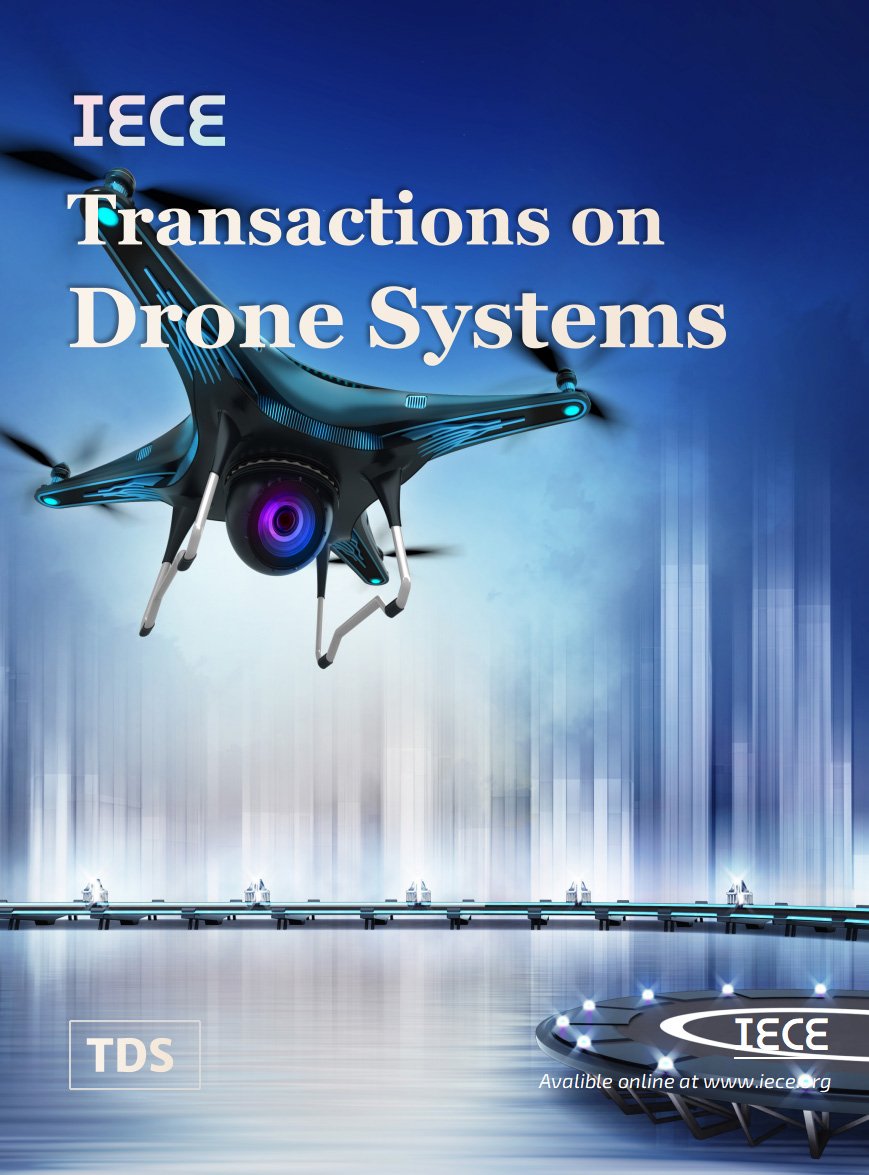As the Editor-in-Chief, I am excited to introduce our forthcoming journal, IECE Transactions on Drone Systems. The journal is committed to advancing drone systems by offering a platform that enables researchers, industry experts, and regulatory authorities to exchange ideas that support ongoing research initiatives and standardization efforts in this emerging field. The research initiatives concentrate on state-of-the-art advancements that propel autonomous flight operations, physical design, navigation systems, control protocols, information security measures, artificial intelligence, and drone applications.
Over the last few decades, drone technology has evolved from specialized applications to more essential operations such as agriculture, logistics, healthcare, and surveillance [1, 2]. Integrating cutting-edge technologies such as Artificial Intelligence (AI), Blockchain, Sixth-Generation (6G) networks, Digital Twin technology, and the Metaverse provides an exceptional prospect for advanced drone systems.
Integrating AI into drone systems gives users three essential advantages: autonomous navigation with real-time data processing and intelligent decision-making functions [3]. AI-powered drone systems succeed at all operational levels because they perform precision agriculture functions and support disaster relief and urban safety management. The capability of drones gets an added boost through Federated Learning (FL) because this approach enables decentralized AI training for drone systems, enhancing autonomy, security, and efficiency while preserving data privacy [4].
6G networks promise to revolutionize drone communications with their features of very high data rates and extremely low latency [5]. Drones part of a 6G network can support real-time analytics and seamless coordination among multiple drones, and the Base Station (BS) simultaneously will open up new possibilities in swarm intelligence, autonomous traffic management, and mission-critical operations. Blockchain technology also aligns with the journal's scope on information security by ensuring decentralized and tamper-proof security between drones and BS communication. Autonomous air traffic management achieves trust through its decentralized ledgers, making it easier to transfer data across multiple industries securely [6].
Innovations in drone physical designs can enhance drone performance, endurance, and payload capacity [7]. Drone performance is significantly improved using lightweight materials with modular designs and suitable propulsion systems. Similarly, advanced navigation systems, combined with sensor fusion with adaptive control algorithms alongside robust Inertial Measurement Units (IMUs), are essential in enabling precise autonomous flight in complex environments.
Digital Twin technology has recently evolved as a tool to enhance drone operations [8]. Operators can perform accurate performance tests, predictive maintenance checks, and operational planning sequences through virtual drone models. The method shortens drone operational delays while making drone systems more productive. Another emerging technology, Metaverse, can enhance drone applications in remote inspection services and collaborative military operations [9]. Through augmented and virtual reality technologies, operators can gain better situational awareness during dangerous compound missions.
Despite the promising opportunities mentioned above, drone systems face substantial challenges, particularly regarding information security, mechanical problems, energy efficiency and regulatory concerns. Traditional cryptographic methods will become increasingly susceptible to quantum attacks because quantum computing technology represents a serious security threat to drone communications. Post-Quantum Cryptography (PQC) and other quantum-resistant algorithms can be implemented on drone systems to secure against the emerging threats of attacks launched through quantum computers [10]. Due to the resource-constrained nature of a typical drone, developing lightweight PQC algorithms is the main focus of research these days.
Different mechanical problems, from aerodynamic efficiency through vibration control to energy management, represent substantial technical barriers that need addressing [11]. Typical drones, specifically when they carry heavy weights, need robust energy management solutions to raise their maximum flight times and operational ranges. Drone operations face an ongoing energy efficiency problem that reduces operational distances and extends flight times [12]. Hybrid power systems have seen advancements in solar-powered drones and hydrogen fuel cells, providing promising pathways for future drone development. Energy performance optimization research needs to preserve operational capabilities to achieve extended drone missions and enhanced drone capability.The implementation of drones encounters various regulatory barriers which make their deployment more difficult. A complex regulatory framework exists for UAS manufacturers and operators due to the lack of international standards and airspace management and privacy concerns [13]. The drone industry requires sustainable development through proper regulations, which safely blend new technologies with privacy control measures.
To fully realize the potential of advanced drone systems, several strategic research directions must be prioritized:
Quantum-Resistant Security Protocols: Research needs to design PQC algorithms that will secure drone communication channels from quantum-based threats. Due to limited computing capability, developing lightweight PQC algorithms is the central area of research in this field.
Advanced Physical Design and Mechanics: Research into lightweight composite materials, energy-efficient propulsion systems, and modular designs must be initiated for drone performance improvements and expanded capabilities. Flight stability and efficiency benefit enormously from aerodynamics research and vibration control investigation.
Energy Optimization Solutions: The operational span of drones depends heavily on better energy storage technologies, which incorporate hydrogen fuel cells and solar power. Researchers need to research power systems that combine different sources to maximize operational effectiveness while maintaining high efficiency rates.
AI-Driven Autonomy and Swarm Intelligence: Research into autonomous decision-making AI algorithms along with swarm intelligence requires immediate expansion. FL presents a solution for drone collaboration through collaborative learning processes while protecting data privacy.
Secure Data Management with Blockchain: Researchers must optimize blockchain protocols, ensuring efficient handling of high transaction volumes for drone network operations [14]. Implementing tamper-proof secure ledgers will enhance drone communications' trust and security.
6G Networks and Edge Computing: Developing protocols that leverage 6G networks for ultra-low latency communications is critical for real-time analytics and autonomous flight. Research should also explore edge computing to offload processing tasks from drones, enhancing efficiency.
Digital Twin for Predictive Maintenance: Expanding research on Digital Twin technology can improve the reliability and efficiency of UAS operations. Predictive maintenance powered by AI-driven analytics can help identify potential failures before they occur, minimizing downtime.
Harmonized Regulatory Frameworks: Collaborative research between industry stakeholders and regulatory bodies is essential to develop unified standards for UAS operations. Focus areas should include air traffic management, privacy safeguards, and international compliance for seamless cross-border missions.
We believe these are just the exciting beginning of the practical application of drone systems. Driven by rapid technological advancements, drone systems are set to transform diverse fields such as logistics, agriculture, security, healthcare, and environmental monitoring, bringing unparalleled convenience and innovation to society. The journal IECE Transactions on Drone Systems welcomes active contributions from researchers and industry experts. We invite submissions exploring a broad spectrum of topics in drone systems, encompassing intelligent algorithms, machine learning, and advanced control systems, as well as computer vision, object detection, and autonomous navigation. Research on multi-sensor integration, data analytics, and intelligent sensing within embedded systems is highly encouraged. We also welcome studies on advanced physical design and mechanics, AI-driven autonomy and swarm intelligence, secure data management using blockchain, 6G integration, energy efficiency, information security, and regulatory frameworks. Additionally, we seek applied research on drone technologies in diverse fields such as agriculture, logistics, security, environmental monitoring, and emergency response. We look forward to receiving your original research papers, in-depth discussions, and review articles, as we share and drive the development of drone systems worldwide.
Thank you for your support!
We look forward to embarking on a bright future of intelligent drone systems together!




 Copyright © 2025 by the Author(s). Published by Institute of Emerging and Computer Engineers. This article is an open access article distributed under the terms and conditions of the Creative Commons Attribution (CC BY) license (
Copyright © 2025 by the Author(s). Published by Institute of Emerging and Computer Engineers. This article is an open access article distributed under the terms and conditions of the Creative Commons Attribution (CC BY) license (